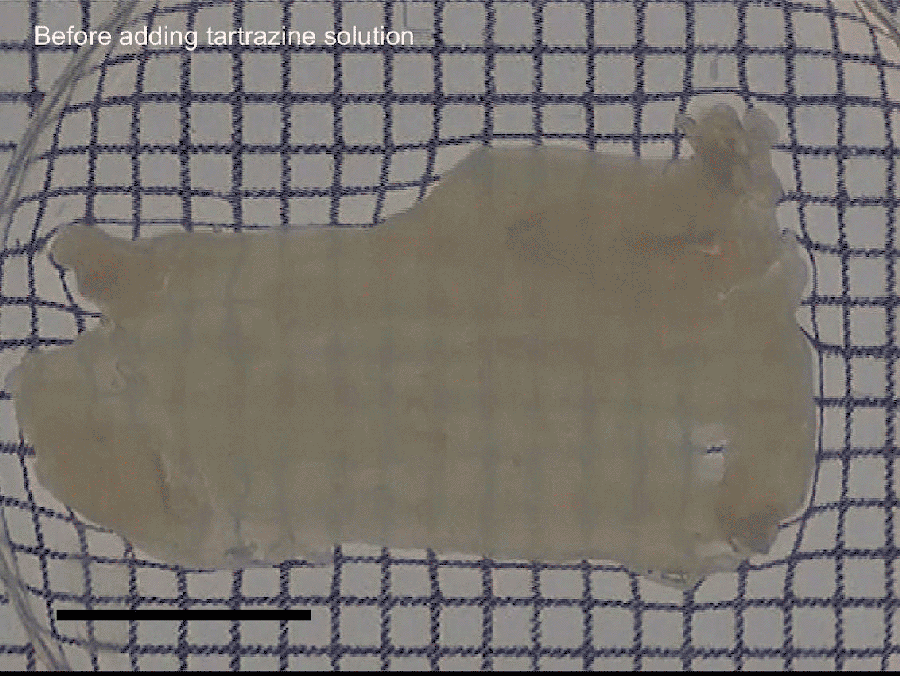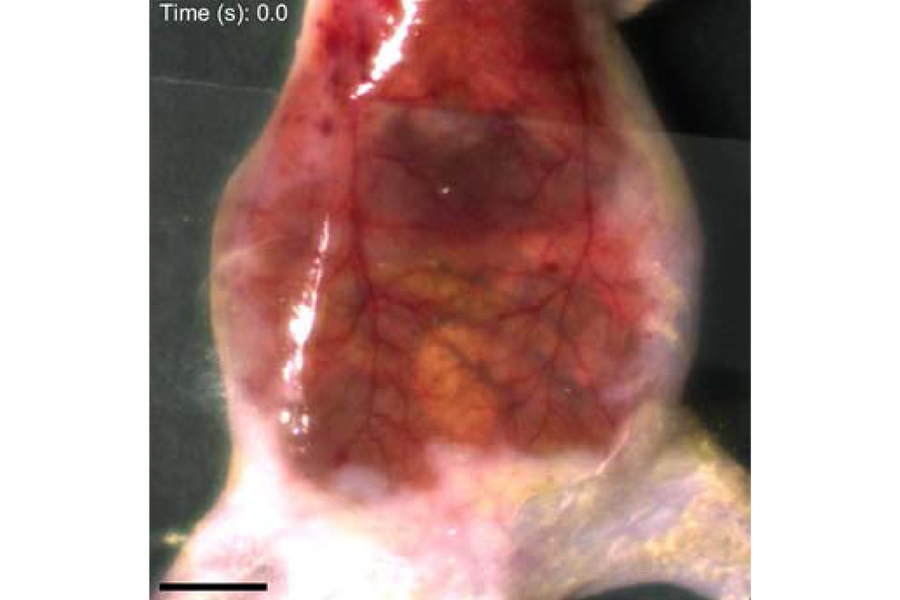September 5, 2024
Thank you for reading this post, don't forget to subscribe!4 min read
New research harnessed the highly absorbent dye tartrazine, used as the common food coloring Yellow No. 5, to turn tissues in living mice clear—temporarily revealing organs and vessels inside the animals

Skin normally scatters light, a phenomenon represented by white lines in the beginning of this clip. When the food, drug and cosmetic dye Yellow No. 5 is absorbed by skin, however, it reduces scattering and allows light to penetrate deeper, making the tissue transparent. (This technique has not been tested on humans. Dyes may be harmful. Always exercise caution with dyes and do not consume them directly, apply them to people or animals or otherwise misuse them.)
Keyi “Onyx” Li/U.S. National Science Foundation
In mere minutes, smearing mice with a common food dye can make their skin almost as transparent as glass.
For a study in Science, researchers spread a solution of tartrazine, a common coloring for foods, drugs and cosmetics, onto living mice to turn a portion of their tissues clear—creating a temporary window that revealed their blood vessels, muscles and internal organs. The procedure has not yet been tested in humans, but it may someday offer a way to view and monitor injuries or diseases without the need for specialized imaging equipment or invasive surgery.
Skin, like most mammalian tissue, is highly opaque because its mix of water and densely packed lipids, proteins, and other essential molecules scatters light in all directions. “The concept is similar to bubbled water,” says the study’s lead author, Zihao Ou, a physicist at the University of Texas at Dallas. Water and air are transparent separately, but mixed together they form cloudy microbubbles, Ou adds. Think of a rushing river or a crashing wave. The clarity changes because water and air molecules have different refractive indexes—the amount of light bent while passing through an object or substance. The fats and proteins in rodent or human skin typically have higher refractive indexes than the water, creating a contrast that you can’t see through.
On supporting science journalism
If you’re enjoying this article, consider supporting our award-winning journalism by subscribing. By purchasing a subscription you are helping to ensure the future of impactful stories about the discoveries and ideas shaping our world today.

Hydrogel samples that mimic human tissues’ optical distribution showing increasing tartrazine concentrations.
Guosong Hong/Stanford University
In the new study, Ou and his colleagues looked for light-absorbing molecules that could make the various refractive indexes within the layers of skin more similar, essentially reducing the amount of scattered light.
The team investigated 21 different synthetic dyes before landing on the highly absorbent tartrazine, more commonly known as Yellow No. 5. The zingy lemon-yellow coloring is approved by the U.S. Food and Drug Administration for use in limited quantities and is commonly found in chips, sodas, candies, butter, vitamins and drug tablets. Tartrazine in solution increases the refractive indexes for red and yellow light, and it absorbs most light at wavelengths in the near-ultraviolet and blue spectra. When the dye is applied to mouse skin, these combined effects reduce the scattering of light that gives the tissue its usual opacity.

Animated stills from a real-time imaging video show the dynamic process of a chicken breast tissue that transitions from opacity to transparency after immersion in a 0.6-molar solution of tartrazine (Yellow No. 5). The progression begins before the tartrazine solution’s application and then shows a range of 0.2 to 60 seconds after. The scale bar represents 5 mm.
Guosong Hong/Stanford University
“The higher the absorption, the more efficient the molecule is,” Ou explains. The fda’s limits on chemicals and additives have caused the food industry to look “for chemicals that are extremely efficient,” even in small amounts, he says.
The researchers tested various concentrations of the dye on hydrogel samples that mimic human tissues’ optical distribution and on slices of raw chicken breast. They then gently massaged the dye into the skin of anesthetized mice until it was absorbed. In less than 10 minutes the team began to see internal features underneath the top layers of tissue. Under visible light, tartrazine rubbed onto the animals’ abdomens revealed their digestive tracts in action; spreading it onto a leg exposed muscles. Using high-resolution laser imaging, the scientists also saw details of nerves in the gastric system, small units in muscles called sarcomeres and, when the dye was applied to the scalp, even structures of the brain’s blood vessels. If the tartrazine wasn’t washed off, the effect lasted about 10 to 20 minutes before the skin returned to its original state.

A still image of a real-time video demonstrates the optical transparency in a mouse abdomen, enabling the visualization of the animal’s abdominal organs. The scale bar represents 5 mm. (The red hue is from the dye.)
“Achieving Optical Transparency in Live Animals with Absorbing Molecules,” by Zihao Ou et al., in Science, Vol. 385. Published online September 5, 2024
Related research has focused on using already transparent materials that absorb into the skin, including glycerol and fructose solution. Those molecules can also reduce light scattering but are “not as efficient [as tartrazine] because they are not ‘colored’ enough,” says study co-author Guosong Hong, a materials science engineer at Stanford University. Other approaches that remove essential molecules in tissues rather than adding new ones produce similar effects but can be done only in nonliving animals or biopsied tissue.
Although it is far from human trials, the new process may someday have helpful medical applications. Hong proposes that related techniques could potentially assist in early skin-cancer detection and make laser-based tattoo removal more straightforward. They could also make veins more visible for drawing blood or administering fluids via a needle, he says—especially in older people with veins that are difficult to locate.
The strategy may also be a more compelling option than the use of imaging technologies such as magnetic resonance imaging (MRI) and ultrasound for some experiments, including live-animal studies. So says Oregon Health and Science University dermatologist Rajan Kulkarni, who worked on a 2014 study in which researchers replaced the lipids in whole organs and animals with clear hydrogel to see inside. “It would give you the ability to visualize at light-microscopy resolution, whereas other methods of MRI, CT [computed tomography] and ultrasound are not as finely resolved,” Kulkarni adds. “In terms of a proof of concept, it’s really fantastic. Clinically, it remains to be seen.”
The study authors didn’t observe any adverse side effects in the mice after the tartrazine was removed, although Ou says it could cause temporary damage to skin tissue. He adds that this dye and similar, more efficient molecules must be further tested for human safety. Tartrazine can cause allergic reactions. And although the coloring is fda-approved, the agency has strict limits on amounts used in products. In the study, the mice were able to tolerate the highest concentration used, 0.6 molar, during the short testing periods. But “human skin is about 10 times thicker than [that of] mice, which means that the time required for diffusion is probably much greater—a few minutes for mice is going to be hundreds of minutes for humans,” Ou says. “We hope that with our initial work, there will be more follow-up proposing new molecules that are going to be more efficient and safer for human application.”

